The Magic Box (1951) and Nickelodeon (1976)
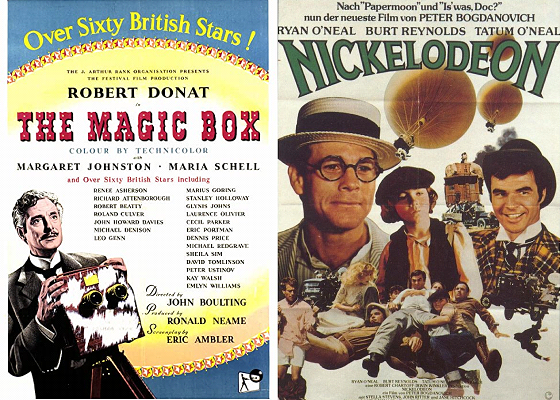
Toronto Film Society presented The Magic Box (1951) on Monday, June 20, 1983 in a double bill with Nickelodeon (1976) as part of the Season 36 Summer Series, Programme 1.
THE MAGIC BOX (1951)
Production Company: Festival. Producer: Ronald Neame. Director: John Boulting. Screenplay: Eric Ambler. Source: (Book) Ray Allister (Friese-Greene).
Cast: Robert Donat (William Friese-Greene), Margaret Johnston (Edith Harrison), Maria Schell (Helen Friese-Greene), John Howard Davies (Maurice Friese-Greene), David Oake (Claude Friese-Greene), Renee Asherson (Miss Tagg), Richard Attenborough (Jack Carter), Robert Beatty (Lord Beaverbrook), Michael Denison (Reporter), Henry Edwards (Butler), Leo Genn (Dacres), Marius Goring (House Agent), Joyce Grenfell (Mrs. Clare), Robertson Hare (Sitter), Kathleen Harrison (Mother), William Hartnell (Sergeant), Stanley Holloway (Broker’s Man), Jack Hulbert (Sergeant), Glynis Johns (May Jones), Mervyn Johns (Pawnbroker), Barry Jones (Doctor), Miles Malleson (Conductor), Muir Matheson (Sir Arthur Sullivan), A.E. Matthews (Colonel), John McCallum (Sitter), Bernard Miles (Alfred), Laurence Olivier (PC 94 B), Cecil Parker (Platform Man), Eric Portman (Arthur Collings), Dennis Price (Assistant), Michael Redgrave (Mr. Lege), Margaret Rutherford (Lady Pond), Ronald Shiner (Fairground Barker), Sheila Sim (Nurse), Basil Sydney (William Fox-Talbot), Sybil Thorndike (Sitter), David Tomlinson (Bob), Cecil Troucer (John Rudge), Peter Ustinov (Industry Man), Frederick Valk (Guttenberg), Kay Walsh (Receptionist), Emlyn Williams (Bank Manager), Harcourt Williams (Tom), Googie Withers (Sitter).
INTERMISSION – 10 MINUTES
NICKELODEON (1976)
Production Company: Columbia (Los Angeles/British Lion/EMI (London). Producer: Irwin Winkler, Robert Chartoff. Associate Producer: Frank Marshall. Production Manager: Mel Dellar. Director: Peter Bogdanovich. Assistant Directors: Jack Sanders, Arne Schmidt, Steve Lim. Screenplay: W.D. Richter, Peter Bogdanovich. Photography: Laszlo Kovacs. Special Photographic Effects: Howard A. Anderson Co. Editor: William Carruth. Set Design: Darrell Silvera. Special Effectors: Cliff Wenger. Musical Director/Arrangements: Richard Hazard. Piano Rolls & Cylinders: Lennie Marvin Collection. Song: “Pack Up Your Troubles”. Choreographer: Rita Abrams. Stunt Co-Ordinator: Hal Needham. Stunts: Hal Needham, Julie Ann Johnson, Joe Ansler, Ron Stein, Charles Tamburro.
Cast: Ryan O’Neal (Leo Harrigan), Burt Reynolds (Buck Greenway), Tatum O’Neal (Alice Forsyte), Brian Keith (H.H. Cobb), Stella Stevens (Marty Reeves), John Ritter (Franklin Frank), Jane Hitchcock (Kathleen Cooke), Jack Perkins (Michael Gilhooley), Brion James (Bailiff), Sidney Armus (Judge), Joe Warfield (Defence Attorney), Tamar Cooper (Edna Mae Gilhooley), Alan Gibbs (Patent Hooligan), Mathew Anden (Hecky), Lorenzo Music and Arnold Soboloff (Cobb’s Writers), Jeffrey Byron (Steve), Priscilla Pointer (Mabel), Don Calfa (Waldo), Philip Burns (Duncan), Edward Marshall (Rialto Hotel Clerk), John Blackwell (Louie), E.D. Andre, Christa Lang and Maurice Manson (Stage Performers), Louis Guss (Dinsdale), Frank Marshall (Dinsdale’s Assistant), Andrew Winner, Matilda Calnan, Gustaf Unger, Bertil Unger, James O’Connel, Ric Mancini, Mark Dennis, E. Hampton Beagle, Hedgemon Lewis, Bill Riddle, Dino Judd, Harry Carey Jnr., James Best, Jack Verbois, John Chappell, George Gaynes, Carleton Rippel, Rita Abrams, Sara Jane Gould, Mary Beth Bell, M. Emmet Walsh, Miriam Bird Nethery, Rusty Blitz, Les Josephson, Tom Erhart, Griffin O’Neal, Patricia O’Neal.
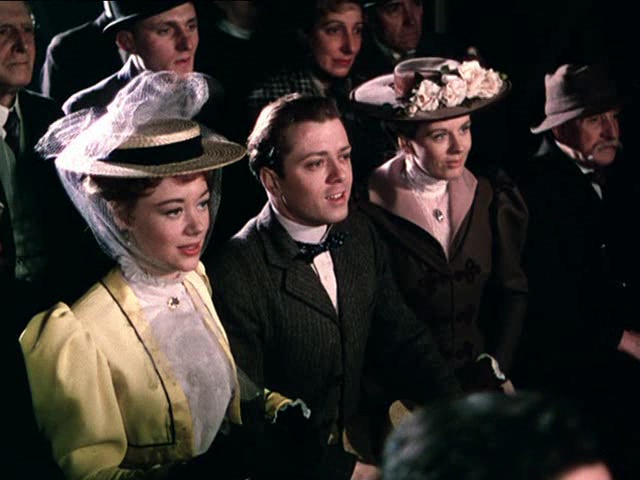
Film, from the beginning, was an international art, springing up, in all parts of the world, at about the same time, each new development almost independent of the others, as though it were an irresistible force bursting out wherever it found outlet. Muybridge photographing animal motion in California in the 1870s, Marey in France developing a camera to record motion in the ’80s, Le Prince first designing a camera-projector in Britain in the same decade, and finally the great climax of cinematic projection in 1895-96, with Edison in America, the Skladanowskys in Germany, and the Lumière brothers in France. It is not possible, therefore, to say with great certainty who invented the motion picture camera, or “magic box”. At very least, the Englishman Friese-Greene (1855-1921) must share the distinction with Le Prince, Marey, Edison, and his assistant W.L.K. Dickson. Robert Donat, as Friese-Greene, acknowledges in The Magic Box his auxiliary role, to his young son, battered by a schoolmate who has denied his father’s place in film history; but he goes on to claim that if he wasn’t the only inventor of the motion picture camera he was at least the first, a dubious claim. Still, we can forgive in The Magic Box a large degree of chauvinism: the film was the British film industry’s contribution to the Festival of Britain in 1951. And Friese-Greene, in 1951, needed to be restored to the Pantheon from which he had disappeared altogether. Behind the titles of the picture are the graven-in-stone tributes to all these pioneers, while Friese-Greene’s name must settle for a mere superimposition on the frame. Only at The End doe he receive his graven monument, by which time we have been persuaded of his contribution to film history.
What is of course remarkable about The Magic Box is not its historical accuracy, but the extraordinary aggregation of talent that it combines into one single film. It may be easy enough to think of a few members of the British acting profession who do not appear–John Gieulgud, Ralph Richardson, Edith Evans spring to mind–but see if you can name more than ten, of the first, second or third ranks. Moreover, there is little of the kind of portentous jokiness about the cameos that marks a few years later Around the World in Eighty Days; the greater sense of professionalism in The Magic Box finds the actors more submerged in their roles, emerging less often to cry “Look, here I am!”
Certainly the most memorable appearance is that of Laurence Olivier, the stolid English bobby brought in from his beat to witness the very first projection of motion pictures. The moment is immortal: on the face of the actor who even in 1951 was a cinematic icon is registered the whole history of cinema as he watches the flickering figures on the sheet (which he must turn to satisfy himself there is nothing behind it). His comment, even, generalizes the moment, linking the invention of film–and why not?–to the discovery of Galileo. “But it moved!”
Though secondary to this one, the list of marvellous performances, etched in a moment or two of time, is almost endless. The performances themselves are a series of reminders of what the motion picture camera hath wrought as both a recording and transforming device. Stanley Holloway as a solemnly facetious bailiff, Margaret Rutherford as an irresistible grande dame, Eric Portman as the crass but practical business partner, Bernard Miles as the suspicious relative who is the subject of the first moving picture; there are even momentary glimpses, and no more, of Sybil Thorndyke, Peter Ustinov, Bessie Love.
But the most attractive performance in the film, for even Lord Larry needs more than three minutes to steal a whole film, at least from Robert Donat, is the star’s. This sensitive actor, crippled through much of his career, and finally cut off in his early fifties, by asthmatic illness, had played predominantly romantic heroes for nearly twenty years, insouciant heroes (The 39 Steps), captious heroes (The Ghost Goes West), resolute, even vengeful heroes (The Count of Monte Cristo), lovably eccentric heroes (Goodbye Mr. Chips–no doubt his most famous role, for which he won an Oscar over Clark Gable in the year of GWTW). His films after the war, as his health deteriorated further, were few, but included a masterful and masterly impersonation of the lawyer in The Winslow Boy; his last three performances, in The Magic Box, Lease of Life, and The Inn of the Sixth Happiness, were all of men either facing death, as he himself was, or whom life had passed by. But in all his roles, even as the avenging Edmond Dantes, there is a strong note of idealism, a quality which in The Magic Box goes far towards indicting the commercialism–a deep-rooted but necessary element in the film industry–which opposes it. The manner of Friese-Greene’s death in the film, where his idealistic valedictory persuades so shell-backed a mogul as Beaverbrook to compose his differences with his business associates, is at some point removed from the real Friese-Greene’s death, which was treated with some indifference by those who had taken over the industry in which he had played a pioneering role.
On the technical side as on the acting, the British film industry put its best foot forward. Ronald Neame, the producer, had photographed some of the best known British films of the war and just after (Pygmalion, In Which We Serve, Blithe Spirit). He went on to produce, still working with David Lean, such films as Great Expectations, Oliver Twist, The Passionate Friends. And in his third career, as a director, later, he made films no less distinguished–The Horse’s Mouth, Tunes of Glory, The Prime of Miss Jean Brodie. Jack Cardiff was another of the best of British cameramen, photographing Stairway to Heaven, Black Narcissus, The Red Shoes, before going to America to work on The African Queen, The Barefoot Contessa, War and Peace. He too became a director in the late ’50s, his best films being highly visualized presentations of ordinary life, mostly urban (Sons and Lovers, Young Cassidy, which he co-directed with John Ford). More recently, he both directed and photographed Death on the Nile (It seems that elephantiasis is the last disease of many a British director!) Eric Ambler, too, the screenwriter, a famous author of thrillers (The Mask of Dimitrios) had written several of the best British films of the period: The Way Ahead, The Passionate Friends, The Cruel Sea, Lease of Life. And finally, John Boulting, the director, one of the famous twin brothers who put their names, usually as producer and director in alternation, to some vintage British films of the postwar years: Fame is the Spur, The Guinea Pig, Seven Days to Noon. Though some of their talents petered out in comedy in the ’60s and ’70s, with such films as Rotten to the Core and There’s a Girl in my Soup, they represented in 1951 the film establishment, and that is what above all presides over The Magic Box.
At one level of apprehension, The Magic Box is a rather commonplace film, the rags to riches to rags story of an impractical idealist, unnecessarily complicated by a convoluted narrative method, which catches the hero in his final poverty, follows him back to his wealth as it declines into poverty, then goes back to his earliest poverty as it becomes wealth before it becomes poverty again! But it is surely best, at last, to appreciate the film for what it is at the level above its lachrymose story: a salute by the British film industry to (pace Beaverbrook) its past, and (thrugh the artists at work on the film) to its past, present and future.
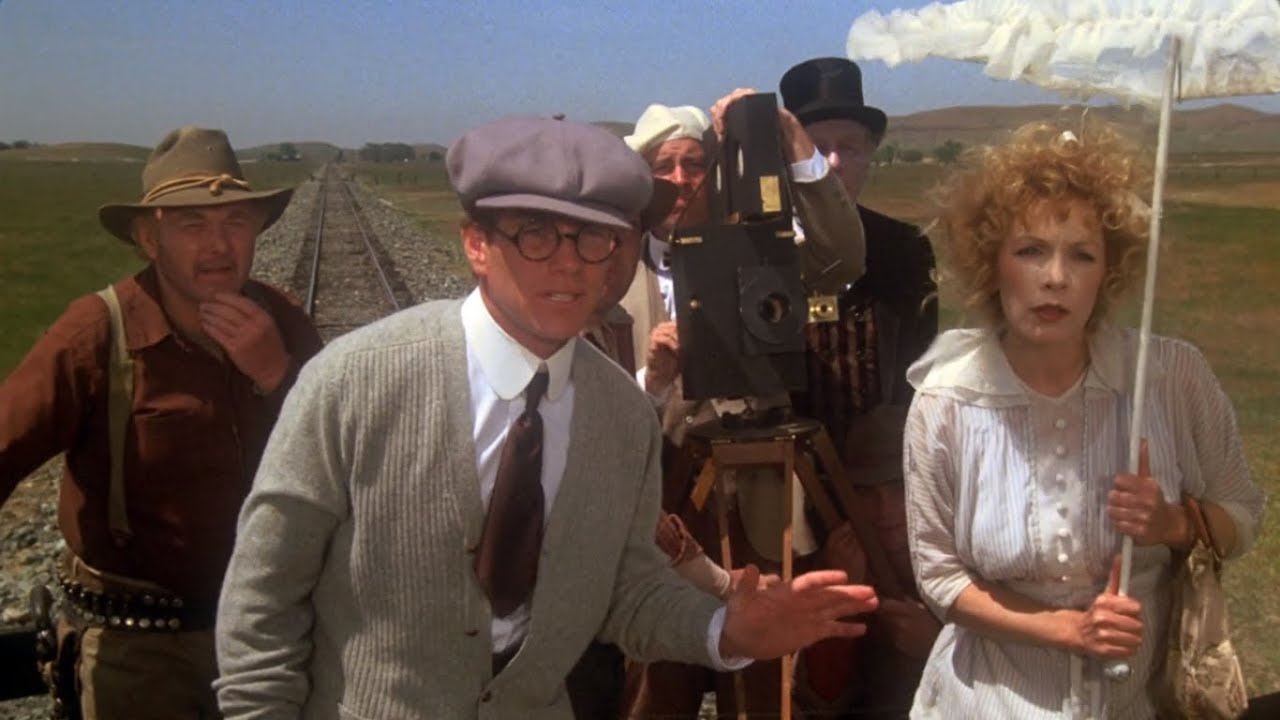
Peter Bogdanovich’s Nickelodeon is another kind of tribute, ostensibly as accurate as The Magic Box, just as nostalgic, and, though in a more easily comic way, just as reverential. Nickelodeon derives its historical accuracy from the respectful ear which Bogdanovich gave to the reminiscences of two old men, the last survivors of the earliest days of filmmaking, Raoul Walsh and Allan Dwan, both of whom died, up in their nineties, in 1980-81. Old men forget, and these two talked, as old men will, not free of exaggeration; from their stories, Bogdanovich transcribed this sometimes slapstick, sometimes serious account of the days when men walked in off the street to direct movies of the standard ten-minute length suited to the nickelodeon, and when the Motion Picture Patents Company, formed by the infant studios to protect their product, launched all-out war against fly-by-night producers and unregistered exhibitors. The picture that emerges is one of a group of amateurs having a great deal of fun in dodging true mayhem and violence with as much ease as the dodge custard pies; and with a general air of improvisation and disorganisation hanging over all.
Bogdanovich is one of the most interesting–and currently least esteemed–of contemporary American directors. He is interesting precisely because he is so emphatically aware of the cinematic past: beginning as a writer on film, the author of books on Ford and Hawks, and of countless reviews, he moved with Targets (1968) to making films which are highly allusive in quality, bespeaking the same kind of attitude to film history and the tradition as such writers as Eliot and Pound express in their poetry towards literary and cultural history. For Bogdanovich, Nickelodeon was a turning-point film, coming after the tributes to Ford in The Last Picture Show and Paper Moon, and the hommage to Hawksian screwball in What’s Up, Doc? Less of a tribute by emulation of the past masters, Nickelodeon was a tribute of detail and historical celebration. But it was also his third flop in a row, coming after Daisy Miller, a valiant cinematic transposition of a work inescapably literary, and At Long Last Love, his ill-judged imitation of the sophisticated movie musicals of the 1930s (or something). These three films failed not only with the critics (which might be expected when an artist they have hailed and therefore feel they have created, stumbles), but also with the general public (who are generally more tolerant, though perhaps not of second-hand Henry James, ersatz Cole Porter, and madcap reminiscence of a period of film history they didn’t know existed–or is it that the charms of Ryan, Tatum, and Burt had begun to grow thin?). Whatever the reason, Nickelodeon signally failed at the box office.
Surely it did not deserve to do so. With enthusiasm and love it pays tribute to a day when movies were made with those very qualities. This product was often rubbish, but so, let us be frank, are Raiders of the Lost Ark and the Star Wars trilogy, films also made–but also received–with love and enthusiasm. And Bogdanovich, for whom self-indulgence has often been the greatest weakness of his art–and it is often in evidence in this very film–has never sunk to the self-indulgent levels of 1941 or Poltergeist.
One of the critics’ chief sneers at Nickelodeon was that the greatest moments in it, and the only ones worth remembering, were the sequences from The Birth of a Nation which made up its climax. Surely, though, it is no slur on a picture to say that it fails to measure up to Griffith’s great epic. Moreover, surely it was Bogdanovich’s point (his point-counter-point) that, while all this improvisation and disorganization was going on in the embryonic film world, there was one artist at work who, though he may have improvised, was never disorganized. The Birth of a Nation, from its incarnation as the Reverend Thomas Dixon’s stage play The Clansman (with Burt Reynolds riding a wooden horse) till the climax of its first screening (with Griffith taking a bow from the stage), is the subtheme of Nickelodeon, and it emerges as the major theme at the end. Bogdanovich’s film ends at the moment of greatest triumph in the early cinema: out of all this chaotic ordure has come artistic order. As Henry B. Walthall thrusts his Confederate standard down the very mouth of the Northern cannon, it is tempting, in retrospect, to see Bogdanovich driving his artistic credo down the vacuous throats of the critics, and the general public.
Notes by Barrie Hayne

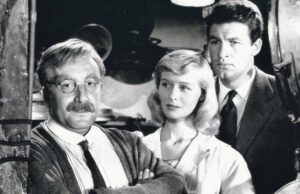
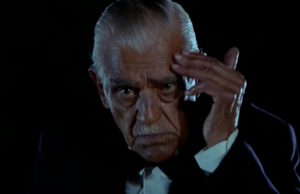
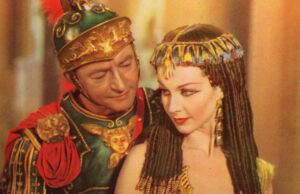






Leave a Reply